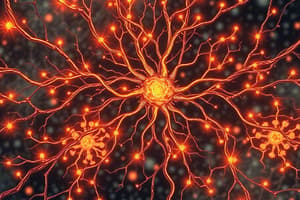Podcast
Questions and Answers
What is the term for the electrical signals used by neurons to communicate with other cells?
What is the term for the electrical signals used by neurons to communicate with other cells?
Nerve impulse or action potential
Describe the charge distribution across the membrane of a neuron at rest.
Describe the charge distribution across the membrane of a neuron at rest.
The inside of the neuron is negatively charged relative to the outside.
What is the role of the sodium-potassium (Na-K) pump in maintaining the resting potential of a neuron?
What is the role of the sodium-potassium (Na-K) pump in maintaining the resting potential of a neuron?
It pumps 3 Na+ ions out of the cell and 2 K+ ions into the cell, against their concentration gradients.
What is the approximate change in membrane potential necessary to reach an action potential, starting from the resting potential of -70mV?
What is the approximate change in membrane potential necessary to reach an action potential, starting from the resting potential of -70mV?
Signup and view all the answers
Name two types of anions and two types of cations that are important in establishing the resting membrane potential?
Name two types of anions and two types of cations that are important in establishing the resting membrane potential?
Signup and view all the answers
What is the term for the 'jumping' of action potentials along the axon in myelinated neurons?
What is the term for the 'jumping' of action potentials along the axon in myelinated neurons?
Signup and view all the answers
What ion is primarily responsible for the depolarization phase of an action potential?
What ion is primarily responsible for the depolarization phase of an action potential?
Signup and view all the answers
What is the membrane potential called, that must be reached for an action potential to be triggered?
What is the membrane potential called, that must be reached for an action potential to be triggered?
Signup and view all the answers
What is the primary function of the Na+/K+ pump in the context of action potentials?
What is the primary function of the Na+/K+ pump in the context of action potentials?
Signup and view all the answers
During the relative refractory period, is it possible for another action potential to fire, and why?
During the relative refractory period, is it possible for another action potential to fire, and why?
Signup and view all the answers
Study Notes
Nerve Impulse/Action Potential
- Neurons communicate with other neurons, muscles, and glands through electrical signals.
- These electrical signals are called nerve impulses or action potentials.
- Hodgkin & Huxley discovered action potentials in the 1940s using an axon from a giant squid.
The Membrane at Rest
- Cells have a specific charge across their membrane.
- The distribution of anions (Cl-, proteins) and cations (Na+, K+, Ca2+) inside and outside the cell determines this charge.
- Inside the neuron is negative (-), while the outside is positive (+).
Resting Potential
- A neuron not transmitting a signal is at its resting potential (approximately -70 mV).
- The inside of the neuron is negatively charged relative to the outside due to negatively charged molecules in the cytoplasm.
- The Na-K pump maintains concentration gradients for sodium and potassium ions, pumping 3 sodium ions out and 2 potassium ions in.
Action Potential
- When nerves are stimulated, they are excited from their resting potential to their action potential (+40mV).
- A sufficiently large stimulus triggers an action potential.
- An action potential is an "all-or-none" response.
Action Potential - Stages
- Stimulus: Opens voltage-gated Na+ channels, Na+ flows in.
- Depolarization: If enough Na+ flows in, membrane potential reaches the threshold, triggering an action potential.
- Repolarization: K+ channels open, allowing K+ to flow out; Na+ channels close.
- Hyperpolarization (refractory period): K+ channels slowly close, potential briefly dips below resting potential.
- Resting Potential: Na+/K+ pump restores ion concentrations back to resting potential levels.
Propagation of Action Potentials
- In myelinated axons, action potentials "jump" between Nodes of Ranvier; this is called saltatory conduction.
- In unmyelinated axons, action potentials travel continuously along the axon.
Multiple Sclerosis (MS) Treatments
- Treatments for MS often focus on suppressing the immune system to prevent immune cells from attacking neurons.
- Some treatments include chemotherapy, anti-inflammatory drugs (steroids), and physical therapy.
- A promising new treatment, autologous hematopoietic stem cell transplantation (AHSCT), involves wiping out the patient's immune system and transplanting their own stem cells.
Graded Potential
- A small region of depolarization transmits a signal a short distance, fading out quickly.
- All cells can generate graded potentials, but neurons, muscle cells, and some endocrine/immune cells can produce action potentials.
Studying That Suits You
Use AI to generate personalized quizzes and flashcards to suit your learning preferences.
Related Documents
Description
Explore the mechanisms of nerve impulses and action potentials in neurons. This quiz covers key concepts such as resting potential and the work of Hodgkin and Huxley. Test your knowledge of how electrical signals facilitate communication within the nervous system.



